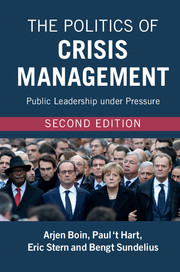Book contents
- Frontmatter
- Contents
- List of Figures
- List of Tables
- Introduction to the Second Edition
- 1 Managing Crises: Five Strategic Leadership Tasks
- 2 Sense Making: Grasping Crises as They Unfold
- 3 Decision Making and Coordinating: Shaping the Crisis Response
- 4 Meaning Making: Constructing a Crisis Narrative
- 5 Ending a Crisis: Managing Accountability
- 6 Learning and Changing: From Crisis to Reform
- 7 How to Deal with Crisis: Lessons for Prudent Leadership
- References
- Index
3 - Decision Making and Coordinating: Shaping the Crisis Response
Published online by Cambridge University Press: 15 December 2016
- Frontmatter
- Contents
- List of Figures
- List of Tables
- Introduction to the Second Edition
- 1 Managing Crises: Five Strategic Leadership Tasks
- 2 Sense Making: Grasping Crises as They Unfold
- 3 Decision Making and Coordinating: Shaping the Crisis Response
- 4 Meaning Making: Constructing a Crisis Narrative
- 5 Ending a Crisis: Managing Accountability
- 6 Learning and Changing: From Crisis to Reform
- 7 How to Deal with Crisis: Lessons for Prudent Leadership
- References
- Index
Summary
The Myth of Top-Down Command and Control
In March 2011, U.S. President Barack Obama presided over five national security meetings at the White House to go over plans for a military operation designed to kill the country's nemesis, Osama Bin-Laden. A few weeks later, Obama gave the final order to strike. In the secure Situation Room deep within the White House, Obama and his most trusted aides watched the operation unfold in “real time” as U.S. Special Forces stormed the terror chief's compound in Pakistan. A photograph released by U.S. officials captured the drama as the group watched the world's most wanted terrorist finally meet his end.
On July 7, 2005, the morning rush hour in London formed the backdrop for a series of suicide attacks. Four suicide bombers detonated one charge each, killing fifty-two people and injuring more than 700. Hundreds of rescue workers were engaged in the response. With the underground closed down and roads gridlocked, authorities faced a dilemma. The traffic situation affected the mobility of the rescue services as well as of citizens trying to get home from work. As long as the public transportation systems remained down, chaos would prevail in the city streets. But if there were more bombs placed on buses or trains, the consequences of a premature restart could be dire indeed.
These very different examples of high-stakes decision making illustrate a classic notion of executive leadership: making the critical call when it matters most. Both successes and failures of crisis management are often related to such monumental decisions. This notion of crises as “occasions for decision making” is a dominant one in the scholarly literature on crisis management. How leaders make such high-impact decisions in turbulent circumstances has – for good reasons – been considered pivotal by generations of crisis researchers.
Many studies of crisis management report an “upward” shift in decision making: the authority to make critical decisions is adjusted to the scale of the crisis. When a crisis strikes areas that extend over multiple administrative jurisdictions, responsibility for coordinating government responses typically shifts to regional, national, or, for some types of crises, transnational levels of authority. The same goes for crises that are local in geographical terms but whose depth and complexity exceed the coping capacity of local authorities.
- Type
- Chapter
- Information
- The Politics of Crisis ManagementPublic Leadership under Pressure, pp. 49 - 77Publisher: Cambridge University PressPrint publication year: 2016



